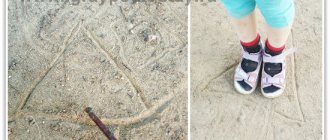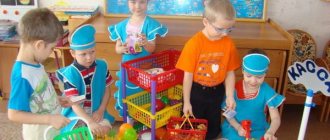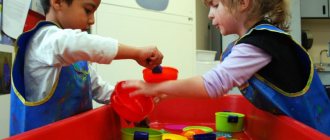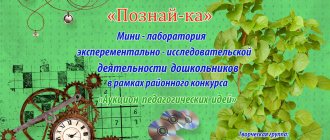How independence is formed and manifested in activities
Independent activity of children is a kind of autonomy. It is understood that the preschooler performs certain actions or solves practical problems without the participation of an adult.
From a theoretical point of view, independent activity requires setting a goal, choosing the means to achieve it, direct implementation, as well as at least minimal control.
Everything looks like a complex algorithm. But in practice it turns into a sequence accessible to the child. For example, looking at cubes or large parts of a construction set, the baby begins to build a tower, similar to the one he built yesterday with his dad. All components of the activity process are present here, but the preschool child himself conceives and implements the idea.
The manifestation of independence does not happen suddenly and instantly. At about 3 years old, the child begins to assert his independence at the everyday level. At first he performs the actions with the help of an adult, but the next step quickly comes when the baby wants to free himself from this help. Every now and then the persistent “I myself!” sounds.
The adult gives the child a model of how to perform the action. Imitation is a child’s primary activity. The preschooler takes independent actions on his own initiative, and he still needs to mature for them.
We can distinguish the stages of development of independent actions, which can be traced in any type of activity that the baby undertakes:
- Joint-shared attempts. They start an activity (drawing, storytelling, any practical activity) together. Then the adult actively helps the child, or even does the main part.
- Performed by a preschooler, but with hints and based on the demonstration of the necessary actions by the mentor.
- The adult proposes, that is, sets a task, and the child copes with it. This stage can be called performing.
- The preschooler himself takes the initiative and performs actions in order to achieve the goal that he sets for himself.
In childhood, the boundaries within which children try their hand are expanding every day. The preschooler begins to show independence in any activity available to him: cognitive, playful, creative, productive.
Organization of independent activities of children in the light of the Federal State Educational Standard for Education
Ekaterina Shadrina
Organization of independent activities of children in the light of the Federal State Educational Standard for Education
Report on the topic
«Organization of children's independent activities
in the light of the Federal State Educational Standard of Preschool Education "
Prepared by: teacher
MKDOU "D/S No. 16"
Ekaterina Aleksandrovna Shadrina
Bakal, Satkinsky district
In the Federal State Educational Standard for Preschool Education, children’s independent activities are highlighted less clearly ,
than joint activities of adults and children . However, in the target guidelines, independence , the ability to choose one’s occupation is paramount. The need for the formation and development of independence is dictated by the needs of society for non-standard people who can think creatively and make discoveries for the benefit of humanity. And the solution to this issue is reflected in the process of developing independence , which allows a person to pose new problems and find new solutions.
The standard states that one of the conditions for the social development of children is :
• supporting children's individuality and initiative through :
creating conditions for children to freely choose activities and participants in joint activities ;
creating conditions for children to make decisions, express their feelings and thoughts;
non-directive assistance to children, support for children’s initiative and independence in various types of activities (play, research, design, cognitive, etc.)
;
The development of independence is an important indicator of a child’s readiness for school, especially emotional and volitional. The child develops the ability to act arbitrarily, regulating and subordinating his behavior to achieve a certain goal, which is set for him by an adult, a group of children , and then himself. By the end of preschool age, a 6-7 year old child sets a goal for himself, takes certain sequential actions to achieve it, and brings the job he has started to completion.
What is “ independence ”
?
1. This is the ability not to be influenced by various factors, to act on the basis of one’s views and beliefs.
2. This is a general characteristic of regulation (control)
the personality of his
activities , relationships and behavior.
3. This is a gradually developing quality, a high degree of which is characterized by the desire to solve problems of activity without help from other people, the ability to set a goal for an activity , carry out basic planning, implement what was planned and get a result adequate to the goal, as well as contribute to the manifestation of initiative and creativity in solving emerging problems.
Independence does not mean complete freedom of action and behavior; it is always within the framework of accepted norms in society, that is, there must be a rule for every need. We, adults, live by rules; there are also certain rules children (in kindergarten there are some, in school - others)
. What rules exist in your groups? (what you took, put it back; don’t shout or run around in the group; don’t disturb others; fold clothes neatly in the locker, say hello to everyone who comes to the group, etc.)
A. A. Lyublinskaya claims that independence does not arise suddenly ; it develops from early childhood on the basis of strengthening simple skills and habits. Scientific research indicates that under conditions of optimal upbringing and training, children can achieve a certain level of development of independence in various types of activities : play, communication, motor, cognitive-research, productive (drawing, modeling, artistic work, labor, music. Thus , these types of activities can and should become independent .
Independent activity of children is one of the main models for organizing the educational process preschool children
1) free activity of pupils in the conditions of a subject-specific developmental educational environment created by teachers, ensuring that each child chooses an activity based on his interests and allows him to interact with peers or act individually;
2) activities of pupils organized by the teacher , aimed at solving problems related to the interests of other people (the emotional well-being of other people, helping others in everyday life, etc.)
.
What place does independent activity ? (in the morning, between OOD and classes, while walking, after sleep, in the evening).
What do you think should be taken into account when organizing independent activities for children ?
- Correct: age characteristics, individual characteristics of children , block (complex thematic)
planning, subject-development environment of the group.
Since the Federal State Educational Standard for Educational Education implies the creation of conditions for children to freely choose activities , in this sense it is difficult to overestimate the importance of a subject-development environment. Let's say again what is a developing subject-spatial environment? A developing subject-spatial environment is a set of conditions that have a direct and indirect impact on the comprehensive development of a child in kindergarten, on the state of his physical and mental health, on the success of his further education, as well as on the activities of all participants in the educational process in a preschool institution. (slide)
What should the subject-development environment be like in accordance with the Federal State Educational Standard for Education ?
-Transformable, content-rich, multifunctional, variable, accessible and safe.
If we talk about the richness of the environment, we assume the presence of activity centers in the group (play, cognitive-research, creative, motor, etc.)
The adaptability of the environment implies the possibility of changing it depending on the interests and desires of the children .
The multifunctionality of the environment presupposes the possibility of varied use of objects, attributes, and natural materials.
The variability of the environment presupposes the presence of different spaces (for play, construction, privacy, etc.)
., ensuring the free choice
of children ; change of play material, the emergence of new items that stimulate children’s .
Availability and security are well-known concepts for characterizing the environment that do not need to be deciphered.
The developing subject-spatial environment in kindergarten should:
• have an attractive appearance;
• act as a natural background to the child’s life;
• relieve fatigue;
• positively influence the emotional state;
• help the child individually explore the world around him;
• give the child the opportunity to engage in independent activities . (slide)
The group space should be organized in the form of well-demarcated zones ( “
,
“playgrounds”
equipped with a large number of educational materials (books, toys, creative materials, educational equipment, etc.). All items must be accessible to children.
Such organization of space allows preschoolers to choose interesting activities for themselves, alternate them during the day, and gives the teacher the opportunity to effectively organize the educational process taking into account the individual characteristics of children .
The equipment of the corners should change in accordance with the thematic planning of the educational process.
Development centers can be centers for:
• for role-playing and director's games;
• for cognitive activity;
• for independent activities of children ;
• for physical activity;
• for board-printed and educational games;
• for experimentation and observation of natural phenomena;
• for relaxation (solitude, communication, etc.)
(slides)
The free activity of children in development centers helps them independently search , engage in the research process, and not receive ready-made knowledge from a teacher.
• Centers can be demarcated (shelves, flooring, boxes, easels, tables and elevations can be used to delimit space, but at the same time, 1/3 of the group space is free for organizing games and activities for a large number of children .
• Furniture and equipment are arranged in such a way as to ensure the free and safe movement of children (there should not be too much open space that would provoke children to run around and endanger other children ).
• "quiet"
and
“noisy”
centers are sufficiently spaced so that children do not disturb each other (noise level affects the desire to move, the level of anxiety and creative abilities
of children ); designing a “solitude corner”
is necessary for the child to relax;
• materials that stimulate cognitive and speech activity of children are included in all centers;
• materials that allow the child to develop independent activities are presented in sufficient quantities;
• centers allow both individual lessons for children and groups of children in small and large groups;
• centers are intended for both independent and joint activities of children and adults , and for conducting certain types of classes;
• for reading, listening to music, relaxing there are enough soft “seats”
(pillows, covered foam mattresses, armchairs, ottomans, etc.)
;
• there are enough tables and chairs in the room so that all children can sit at them at the same time (it is desirable that the tables are small and stand in different places in the group);
• the group room is organized so that educators can simultaneously observe what is happening in most centers;
• all materials, as well as children's drawings and crafts, are hung at the child's eye level;
• each child has an individual place where he can put his things and objects.
Considering that the leading of preschool children At the same time, it should contribute to the development of creative abilities, awaken imagination, activity, teach communication, and vivid expression of one’s feelings.
The environment should provide children with the opportunity to act individually or together with peers, without imposing mandatory joint activities . The teacher can get involved in the activities of children in cases of conflict situations that require the intervention of an adult, or, if necessary, help a particular child join a peer group.
Play in kindergarten should be organized , firstly, as a joint game between the teacher and the children, where the adult acts as a playing partner and at the same time as a carrier of a specific “language”
games.
The natural emotional behavior of the teacher, who accepts any children’s plans, guarantees freedom and ease, the child’s enjoyment of the game, and contributes to the desire in children to master the methods of play themselves.
Secondly, at all age stages, play should be preserved as a free independent activity of children , where they use all the play tools available to them, freely unite and interact with each other, where the world of childhood is ensured to a certain extent, independent of adults
Along with play, free productive activity of children (constructive, visual, etc.)
Just like in a game, the child’s development opportunities are enriched here.
The teacher can plan children’s independent activities , taking into account what is relevant for a given day (or week).
topics, set goals and objectives of educational work during the day, i.e. the principle of a comprehensive - thematic construction of the educational process in a preschool educational institution must be implemented.
The teacher “starts”
from this topic when
organizing children’s independent activities .
Thus, the independent activity of children in a preschool educational institution is an activity that is carried out without the direct participation of the teacher, on his instructions, at a time specially provided for this, while the child consciously strives to achieve the goal, using his efforts and expressing in one form or another the result of mental or physical actions.
Preschooler's independence in play
Play is the most natural activity in preschool age and the leading activity in a child’s development. In play settings, children discover themselves and social relationships. A role-playing game is an ideal environment for developing independence.
The adult is present in the child’s play activities, but indirectly, through a role. That is, children see the behavior and attitudes of the adults around them, take them as a model, and then model them in their games.
The play of younger preschoolers is mainly imitation. They try to copy gestures and tonality of statements. They scold “offending” dolls, just like a mother. They show concern, playing the role of a doctor, etc. However, the choice of plot, the selection of substitute objects (what will be a thermometer, and what will be a plate of porridge) occurs independently.
Thanks to the effective embodiment of the role, children acquire work skills in the game. If according to the plot you need to clean the room, then the baby takes on putting away scattered things or sweeping.
With the development of play activity, children show more and more independence. They complicate plots, distribute roles, agree on rules, and themselves control their implementation.
Why does your preschooler need free play?
- Nikolaeva Irina
- March 7, 2021
- Preparation for school
Children interact with the world around them through play. Free play in early childhood is about exploration, experimentation, discovery and learning.
What is free play?
There are two types of play activities - adult-led play and child-led play. Both are important for a child's development.
You can't just let your child play 24 hours a day and grow on his own, but you also shouldn't fill his days with activities that take up his free time.
And time spent behind the tablet screen should not replace free play. This will only lead to developmental problems and difficulties in learning at school.
Here are some examples of adult-led play activities:
- drawing with your child
- setting up an obstacle course in the garden
- take your child to a pottery class or art class
- play the game i spy
Free play is any play that is initiated by the child. Outdoor play and indoor play can be considered free play as long as your child has free control over their play experience.
If you are a teacher or parent who understands the importance of a child's general intellectual development and appreciates the importance of a play-based approach for preschoolers, you will enjoy a comprehensive school preparation program.
Free Play Examples
- Outdoor games - tricycle riding, climbing, running, chasing, swinging, etc.
- changing clothes
- block game and construction
- puzzles
- play games indoors (such as board games)
- competitive outdoor games
- playing in sand and water
- creative art
Why is free play so important?
During preschool, much of a child's development occurs during free play. A smaller portion will come from adult-led activities.
Preschoolers are in the developmental stage of informal learning through play. Forcing academic and formal learning will not prepare your child for school.
Free play is responsible for:
- Personal, social and emotional development of the child
- Cognitive development and problem solving ability
- Physical development
- Development of language and communication skills
- Healthy Brain Development
Here's a quick look at 12 areas where free play will evolve.
Brain Development
Free play is important for a child's overall brain development. As children explore and learn, they form new connections and pathways in the brain.
A child's brain processes data twice as fast as an adult's. This is a significant amount of brain development. The stimulation a child receives early in life determines how many neurons are formed and which are not.
Creation
Play is a creative activity. Children are constantly coming up with new games and activities to entertain themselves.
For example, during fantasy play, children create stories and events and act them out as if they were happening. In artistic activities, children develop visual creativity. When you play with construction toys, building design gets creative.
Social skills
The first way a child can learn social skills is by interacting with their parents. After this, social interaction is built by playing with siblings or friends.
During free play, children learn many social skills, such as:
- cooperation with others
- play with others for a common goal
- negotiation
- learn to follow the rules
- think about others and see their points of view
- fair and independent conflict resolution
- Affirming myself
- following someone else's example
- sympathy and empathy
- socially acceptable behavior
- effective communication
Planning skills
Planning skills are important in early grades. They help the child learn to plan before starting work or to complete a task logically and within a given time frame.
During the game, planning skills are constantly improved. Whether a child plans a house before building it or plans where to stick a picture on a page, with time and practice he will develop the ability to plan.
Planning is a skill that requires careful thought and consideration. The child learns to think about the desired outcome before starting and takes time to think about how to complete the task.
A child with poor planning skills might start to draw a picture of his family but run out of space on the page for some of his family members, while a child with good planning skills will first look at the available space and decide how much space each person will take up on the page.
Playing a game is a great way to practice physical planning before moving on to planning on paper.
Motor development
A child's gross motor and fine motor skills develop largely through free play. Children need well-developed motor skills to learn to read and write.
Children develop motor skills from the center of the body to the extremities. In other words, their big muscles develop first, and then their small ones.
Large muscles are developed through free play such as:
- walking and running
- mountaineering
- jump, jump and bounce
- crawl
- push and pull
- catching and throwing
Small muscles are developed through free play such as:
- play with the pegboard
- modeling plasticine
- building with blocks or construction toys
- drawing and painting
- cutting and pasting
- threading and lacing
In recent times, increased tablet use and decreased gaming time have had a huge impact on children. More and more children have underdeveloped motor skills and, as a result, have difficulty learning.
Problem solving
Every child will face many challenges during their gaming sessions. They'll have to figure out how to stop their tower from toppling over, how to make a tent out of blankets, or how to change the rules of the game to make everyone happy.
Knowing how to solve problems is a skill that is needed in school and in adulthood, and even a critical skill needed in every person's career.
The beauty of problem solving during play is that when children are relaxed and engaged in what they choose, they don't see problems as problems. Rather, they are simply problems that need to be solved.
The more a child is interested in solving a problem, the more determined he will be.
This is a healthy approach to adulthood where problems can never be avoided and are best seen as challenges.
Speech development
Children usually verbalize what they are doing during play, even when they are alone. Not only do they increase their vocabulary , but they also practice language structures and sentence construction.
Playing with others provides even more opportunities for language learning as they interact and learn from each other.
Independence
When children are used to having free time to play every day, they develop a sense of independence and enjoy socializing with themselves and their peers.
As a parent, it is important not to be present at every play session, otherwise your child will develop a dependence on you to always be there.
This is also true for play, which is a healthy and important part of a child's youth. Try not to plan any aspects of the date and allow your child to exercise her independence as she plans the play session and learns to entertain her friends without needing adult guidance.
Visual perception
Visual perception is the brain's ability to interpret what it sees. This is very important for learning to read and write and the ability to recognize letters, words, patterns, etc.
Visual perception skills include:
- visual memory
- serial memory
- visual discrimination
- visual closure
- visual perception
- perception of shapes
- depth perception
- figure-ground perception
- visual analysis and synthesis
This skill develops naturally as you play.
Auditory perception.
Auditory perception is the brain's ability to interpret what it hears. This is no less important for learning to read.
Before a child can learn to identify and work with letter sounds, he or she must develop an understanding of sound and the patterns in sounds.
Again, this develops naturally as the game progresses.
Auditory perception skills include:
- auditory discrimination
- auditory memory
- auditory analysis and synthesis
- auditory foreground perception
Spatial perception
When a child understands his body in relation to the world around him, he develops spatial awareness.
Children can develop this by climbing tunnels, running, playing outdoor games, crossing the midline, etc.
Children with poor spatial awareness often bump into others during play or have poor body awareness and understanding of their position in space.
If a child does not have a developed sense of space, he will have difficulty later, especially when writing letters and words and placing his work on the page. They must first learn this skill on a physical level, with their own body, before they can understand the space on paper.
Personal health.
Last but not least, play is a way for children to express themselves and understand the world.
During these activities, the child has a safe way to act out his emotions and learn to cope with them. Children use play as an outlet to express their feelings about the world and everything that happens in it.
Here are some of the ways free play will help your children grow. Never feel guilty if your children are “just playing.” This is the best they can do!
Independent creative activity
Independence in creative activity develops gradually both in simple exercises and when the child becomes involved in artistic activities. At first, careful intervention from an adult is necessary to help with specific operations.
The youngest preschooler is just beginning to master the tools necessary for creativity. Holds a pencil confidently, but draws mostly chaotic lines. Already making some constructions, but only the simplest ones.
The field for the manifestation of creative independence in early preschool age is still gaining diversity. It is presented:
- Drawing
- Making mosaic pictures
- Construction from large parts
At 3-4 years of age there is already interest in independent creative activities. It seems that the baby is engrossed in rolling the car while the mother is putting together a mosaic figure and unsuccessfully trying to get the child interested in this activity. And after some time, the baby himself, albeit chaotically, connects the elements of the mosaic or builds a bridge according to the model. Some children will agree to little help. Others will only accept the suggested name.
In middle preschool age, interest in the musical field intensifies. If earlier children pressed the keys of children's musical instruments and rejoiced at the sound they produced, then by the age of five they are interested in chords. Preschoolers pick up the melody by pressing 2-3 keys in a row and begin to experiment with sounds.
Five-year-old children discover word creation. This is an important stage of speech development - the grammatical structure of speech is formed. What words do children come up with! Moreover, they do this not at the behest of an adult. It's time to encourage your child to write his own stories. An adult can offer a preschooler a series of pictures and ask them to tell a story.
Independent creativity of older preschoolers
Older preschoolers do not need such support for their artistic or design experiments. They prefer to hear feedback only about the result. They plan, select funds, and also carry out their plans without outside help.
Of course, children eventually expect to hear praise. At the very least, support, but not criticism. If a child diligently created his drawing or appliqué, then he wants to receive a positive assessment, and not a remark that not everything was successful.
Negative assessments suppress the need for independent activity of this type. Drawings are not praised - the preschooler loses the desire to draw. If they don’t admire the craft, the child’s interest will fade as well.
The preschooler’s motivation for independent action will not disappear; it will manifest itself in other areas. However, it is important for adults to take into account that creativity should not be taken risks and that it is worth supporting the preschooler.
A fairly high level of speech development in older preschoolers opens up primary literary creativity for them. They make up their own stories and rhyme words. Such exercises are characterized by a high degree of independence. If an adult asks a 5-6 year old child to compose a fairy tale, he will most likely refuse. It’s another matter if this impulse comes from within, and the preschooler himself decided to come up with an amusing story.
The goals of writing can be different - to fantasize about what you want, to repeat a memorable plot with a focus on your life, to make your loved ones or friends laugh. In any case, such creativity perfectly develops speech and imagination, and also forms creative initiative.
When guiding children’s independent activities, the teacher primarily influences their emotional state, supporting positive emotions. Children are especially pleased by shared experiences while observing their surroundings and shared games. At the same time, the teacher directs the kids to play. If the child cannot find something to do, the teacher teaches him actions that he has not yet mastered, switches from one type of activity to another, complicates it, prolonging it, evaluates the child’s actions, what he does.During the child’s independent activity, the teacher shapes his behavior: teaches him to follow the rules of the game, shows where and with which toy it is more convenient to play (at the table, on the floor, near the window), fosters a caring attitude towards toys, teaches him not to throw them away, and to put them back in their place. The teacher pays great attention to the formation of positive relationships between children: he teaches not to interfere with each other’s games, arouses interest in them, encourages the ability to play side by side in the first joint games, develops feelings such as goodwill, affection for group mates, sympathy, help, and the ability to share favorite thing.
When guiding children’s games, the teacher also forms mental processes - attention, memory, imagination; stimulates speech activity, supporting any requests from children to it, and causes the need for verbal communication.
Playing games together with a child opens up great opportunities for shaping the child’s personality, showing initiative, independence, and curiosity. Under the guidance of an adult, playing with him, the child learns to fulfill his specific requirements: collect toys and put them in their places, return an object taken from another child. At the same time, children should well understand the meaning of the words “cannot” and “possible.”
What are the methods for guiding children's play?
First of all, the teacher enriches the children's impressions. For example, in the presence of children, a teacher can water flowers, sew on a button, or clear snow from paths on the street, while arousing their interest in their work. During a walk, it is advisable to watch with children the play of older children and the actions of adults. Special displays of certain actions enrich the child’s experience: he independently bathes the doll, feeds it, and puts it to bed.
Organizing and directing the children’s play, the teacher plays out various scenes: the bear is sick, the cat burned its paw and needs to be treated, the fox carried away the chicken at the moment when Dasha left the room to bring him water, etc.
Methods of teaching young children during independent activities are gradually changing. So, at the beginning of the second year of life, the teacher acts with the child’s hand: for example, together with him he opens and closes the nesting doll, strings rings on the rod of the pyramid and removes them. The main method he uses is demonstration accompanied by words: in the second half of the year, as children develop their understanding of speech, the teacher uses verbal instructions.
It is important that the methods of managing the game gradually become more complex. This can happen by preparing a situation for the development of the game, which, as is known, is prepared by the teacher in the first half of the year, and in the second - he does this either together with the children, or gives the kids independence.
The tasks that the teacher sets for the child also become more complex. By creating “problem situations,” he invites the child not to solve the problem directly, but poses the question so that he can find the answer himself. This method is especially effective because it promotes the development of thought processes during the game. For example, a teacher addresses a child with the words: “Your doll is dirty. Where is our bath, soap, and towel?” However, he does not say that the doll needs to be bathed. In such games, the teacher encourages the child to perform imaginary actions, for example, “pour” water from a toy tap and “give water” to a horse, etc. The game can be complicated by introducing additional objects into it - a comb, a napkin, a thermometer, a bandage (to wipe the doll’s mouth after feeding, take the temperature of a sick bear, bandage a dog’s sore paw). To maintain children's interest in such games, substitute objects should be used: instead of soap - a cube, instead of a spoon - a stick, instead of an apple - a ball.
It is important that the teacher gives the correct assessment of the child’s actions and actions. If the child did a good job, you need to praise him and show other children how well he did.
It is necessary to ensure that conflicts between children are resolved correctly. The teacher expresses his censure to the offender in an appropriate tone. However, when working with children of this age, the most widely used method is distraction, switching the child to another activity.
Analysis of the organization of children's independent activities should be carried out according to certain indicators: the prevailing mood of children in the group; the ability to independently choose a game, the level of development of the activity in which the child is engaged, its duration; the baby’s relationships with surrounding adults and other children; frequency and nature of the child’s speech reactions. The analysis is carried out both in relation to individual children and to the entire group.
Indicators of correctly and well-organized independent activity of children: their good mood, varied use of mastered skills, positive relationships with each other, frequent requests of the child to the teacher about the game, a sufficient number of age-appropriate speech reactions that accompany the child’s independent activity.
Features of organizing independent mathematical activities of preschool children
Independent mathematical activity of preschoolers can have different contents and different directions. At the same time, it is characterized by its occurrence on the initiative of the child himself and its implementation without the participation of an adult.
The features of preschoolers’ implementation of independent mathematical activities are the following:
- Indirect participation of an adult: teacher or parent.
- A game form of implementing mathematical activities.
- Freedom for the child to choose the topic of the lesson, the features of its implementation, the period of implementation, etc.
- Creative approach to implementation of activities. Preschoolers find ways to perform specific mathematical operations, activating their creative thinking.
- Availability of performing actions used in the gaming mathematical process.
- Formation of skills in organizing, planning and implementing diverse types of activities.
- The child takes a subject position in this activity, i.e. he himself sets its goal, determines the content and methods of its implementation, and also sums up the results of the implementation of the activity.
Finished works on a similar topic
Course work Organization of independent mathematical activity of preschool children 490 ₽ Abstract Organization of independent mathematical activity of preschool children 230 ₽ Examination Organization of independent mathematical activity of preschool children 190 ₽
Receive completed work or specialist advice on your educational project Find out the cost





